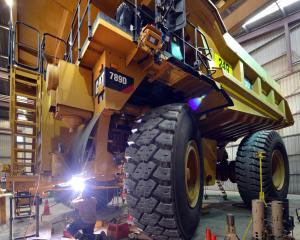Dual-listed Glass Earth Gold is running a fine line between its diminishing cash flows and getting two of its Central Otago exploration prospects into gold production.
Business reporter Simon Hartley and Craigs Investment Partners broker Peter McIntyre consider its latest effort to raise capital and where that could take the company.
Exploration company Glass Earth Gold, whose immediate future is crucially tied to development of its Otago tenements, is seeking to raise $C500,000 ($NZ640,000) in a private placement.
The latest placement is for "general corporate business purposes", but the clock is ticking on Glass Earth's race to get some southern gold from the ground and create a semblance of cash flow, three years to the month it first floated.
Glass Earth has burned through most of $24 million raised during the past four years in a series of placements, while undertaking wide-ranging aerial and ground exploration prospects in both the South and North Islands to zero in on the most promising targets.
Glass Earth delivered its financial report for the quarter to June, booking an almost $1.8 million loss, primarily in exploration costs.
For its previous full year to last December, Glass Earth spent $4.1 million on exploration and booked a $1.33 million loss, having the year before booked a $2.68 million loss.
Glass Earth has $1.2 million cash in hand, plus the proposed $C500,000 issue, to see it through its exploration programme until "early 2010", its chief executive Simon Henderson said in a market update.
He has been candid in the past about running out of cash and the need to underpin the company's immediate cash flows by moving into gold production at its boutique prospects in the Ida Valley and Ophir.
"Glass Earth is finalising regulatory consents and completing preparations for bulk testing at each of its initial placer and hard rock targets" at Ophir and the Ida Valley, Mr Henderson said in a statement to both the New Zealand and Toronto stock exchanges last week.
"Cash generated from placer [loose or alluvial gold] mining at Ida Valley or boutique hard rock mining at Ophir would be additional to this [$1.2 million]," he said.
The company's targets now are separate ventures; Ophir being a 50:50 joint venture with privately owned Ophir Gold Ltd near Ophir, where it is looking at gold trapped in hard rock; and the other a go-it-alone proposition in the Ida Valley in Central Otago, where it hopes to mine placer or alluvial gold (loose particles).
However, with almost 155 million shares already on issue at present, trading around 8c, Glass Earth proposes to release another 10 million at 5c, issue one million by agreement for a Central Otago buy-in, and issue another 100,000 for another Otago project - a total 11.1 million shares.
The latest private placement also carries a 1:1 warrant, exercisable for three years, to purchase a further share for 10c - another 10 million shares.
Craigs Investment Partners broker Peter McIntyre estimates the release of a further 11.1 million shares will dilute share value by about 7%, but it may be the lesser of two evils faced by Glass Earth.
"Don't get me wrong; a [diluting] impact is never good for existing shareholders, but what would have been of more concern was if Glass Earth did not get the funding," Mr McIntyre said.
Two positive points for Glass Earth has been the resilience of gold in recent months, striking and maintaining several records of more than $US1000 ($NZ1388) per ounce throughout September, which has underpinned global investor confidence in gold and gold producer stocks.
"Gold is no longer seen as a boutique asset but has become a mainstream investment to hold; a defined asset class," Mr McIntyre said, highlighting the recent weaknesses exposed in the Euro, British pound sterling and US dollar.
"Being listed on the Toronto exchange is Glass Earth's other bonus.
"Those investors are less risk averse to backing explorers and there's more potential cash available," he said.
While Glass Earth has said the new Canadian funding is for general purposes, Mr McIntyre estimated that based on previous capital expenditure the $C500,000 could underpin Glass Earth a further six months through to the end of the third quarter next year - September.
"However, they can't carry on exploring and spending forever and eating up their cash position.
"Time is running out," Mr McIntyre said.
Glass Earth Gold capital raisings so far
October 2006: $10 million in TSX/NZX float
August 2007: $6.3 million further issue
January 2008: $7.5 million private Canadian placement
October 2009: $640,000 private Canadian placement.
Cash in hand - December 2008, $2.4 million; October 2009, $1.2 million.




